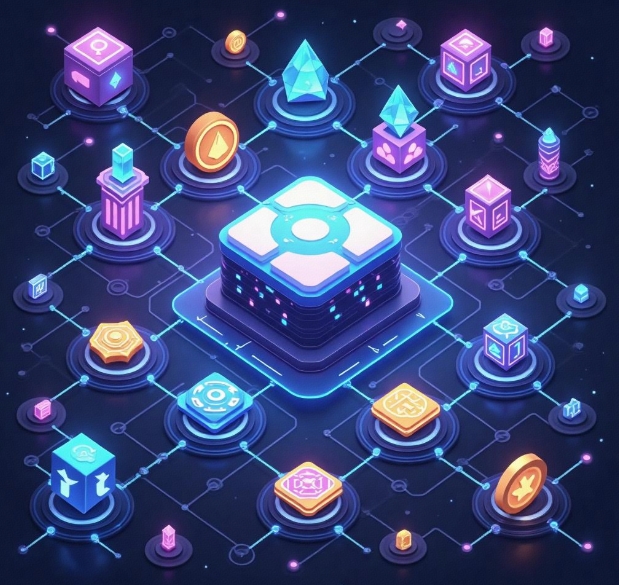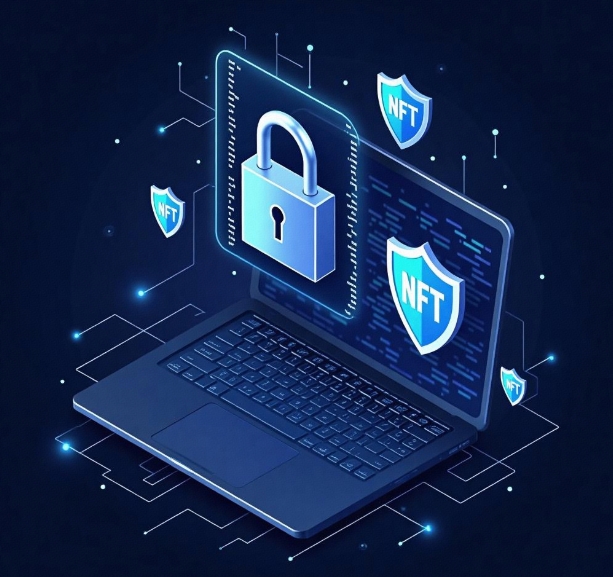Integration of DApps and NFTs: Development of Decentralized Digital Assets
- latest articles
- 1.DApp Development & Customization: Merging Diverse Market Needs with User Experience 2.Analysis of the Core Technical System in DApp Project Development 3.How to achieve cross-chain interoperability in Web3 projects? 4.How does the tokenization of points reconstruct the e-commerce ecosystem? 5.How to Set and Track Data Metrics for a Points Mall? 6.What is DApp Development? Core Concepts and Technical Analysis 7.Inventory of commonly used Web3 development tools and usage tips 8.Development of a Distribution System Integrated with Social E-commerce 9.Six Key Steps for Businesses to Build a Points Mall System 10.What is DApp Development? A Comprehensive Guide from Concept to Implementation
- Popular Articles
- 1.Future Trends and Technology Predictions for APP Development in 2025 2.Analysis of the DeFi Ecosystem: How Developers Can Participate in Decentralized Finance Innovation 3.From Zero to One: How PI Mall Revolutionizes the Traditional E-commerce Model 4.DAPP Development | Best Practices for Professional Customization and Rapid Launch 5.Recommended by the Web3 developer community: the most noteworthy forums and resources 6.From Cloud Computing to Computing Power Leasing: Building a Flexible and Scalable Computing Resource Platform 7.How to Develop a Successful Douyin Mini Program: Technical Architecture and Best Practices 8.Shared Bike System APP: The Convenient Choice in the Era of Smart Travel 9.How to Create a Successful Dating App: From Needs Analysis to User Experience Design 10.From Design to Development: The Complete Process of Bringing an APP Idea to Life
With the rapid development of blockchain technology, decentralized applications (DApps) and non-fungible tokens (NFTs) have become significant forces driving the transformation of the digital economy. DApps rely on smart contracts and decentralized networks to provide users with services without intermediaries, while NFTs grant digital assets uniqueness and immutability through blockchain. When DApps and NFTs are combined, they not only foster innovative development of digital assets but also accelerate the rapid evolution of fields such as decentralized finance (DeFi), gaming, art, and social networking.
This article will explore the core technologies, application scenarios, development challenges, and future trends of combining DApps and NFTs, and analyze how this integration model can build a new generation of decentralized digital economy systems.
I. Core Concepts of DApps and NFTs
1.1 DApp: Definition and Characteristics of Decentralized Applications
DApp (Decentralized Application) is an application that operates based on blockchain technology. Unlike traditional centralized applications (such as social media and payment systems), it has the following characteristics:
Decentralization: The application relies on a blockchain network rather than centralized servers.
Open Source and Transparency: The code is publicly available for anyone to view and audit.
Smart Contract-Driven: DApps primarily implement business logic through smart contracts, ensuring automatic execution and immutability.
Token Incentives: Many DApps use cryptocurrencies as ecosystem incentives to encourage user participation and contributions.
1.2 NFT: The Uniqueness of Non-Fungible Tokens
NFT (Non-Fungible Token) is a type of digital asset based on blockchain technology. Unlike fungible tokens such as Bitcoin and Ethereum, NFTs have the following characteristics:
Uniqueness: Each NFT is one-of-a-kind and cannot be exchanged for another.
Indivisibility: Unlike divisible tokens like Bitcoin, NFTs are typically indivisible.
Smart Contract Support: The creation, trading, and circulation of NFTs rely on smart contracts, enabling decentralized management.
The combination of DApps and NFTs can break through the limitations of traditional application models, offering new possibilities for the creation, trading, and application of digital assets.
II. The Integration of DApps and NFTs: A New Model for Digital Asset Development
2.1 Core Technologies for Combining DApps and NFTs
Blockchain Technology: Provides decentralized storage, smart contract execution, and immutable transaction records.
Smart Contracts: Written in programming languages like Solidity, they enable functions such as NFT minting, transfer, and destruction.
Decentralized Storage (IPFS): NFTs often store metadata, such as images, videos, and music, and IPFS (InterPlanetary File System) provides an efficient decentralized storage solution.
Layer 2 Scaling Solutions: Solutions like Polygon and Optimism improve transaction speed and reduce gas fees.
2.2 Main Application Scenarios
2.2.1 Decentralized Gaming (GameFi)
GameFi (Game + DeFi) is one of the most typical fields combining DApps and NFTs. NFTs represent in-game assets such as characters, equipment, and items, granting players true ownership. Examples include:
Axie Infinity: Players earn income by breeding and battling Axies (NFT characters).
The Sandbox: Offers a decentralized virtual world where users can create and trade NFT land and items.
2.2.2 Digital Art and Collectibles
NFTs grant uniqueness to digital artworks, allowing artists to create and sell their works directly on DApps, bypassing traditional auction houses and galleries. Examples include:
OpenSea: The world's largest NFT marketplace, supporting the creation, purchase, and sale of NFTs.
Rarible: A decentralized NFT marketplace allowing users to freely issue and trade digital collectibles.
2.2.3 Decentralized Finance (DeFi) and NFT Collateralized Lending
NFTs can not only be traded but also used as collateral for loans. Examples include:
Aavegotchi: Combines DeFi and NFTs, allowing users to earn rewards by staking NFTs.
NFTfi: Enables users to collateralize NFTs in exchange for cryptocurrencies, enhancing the financial applications of NFTs.
2.2.4 Social Networking and Identity Authentication
NFTs can also be used in social media and identity authentication, decentralizing personal profiles and social assets. Examples include:
Lens Protocol: A blockchain-based decentralized social network where user identities and data are controlled by NFTs.
ENS (Ethereum Name Service): An NFT-based domain name system providing decentralized identity identifiers for users.
III. Challenges in Combining DApps and NFTs
Although the combination of DApps and NFTs brings numerous innovations, it still faces several challenges:
3.1 High Gas Fees
Congestion on the Ethereum network leads to high transaction costs for NFTs. Although Layer 2 solutions and other public chains (such as Solana and Flow) offer optimizations, further efficiency improvements are needed.
3.2 Smart Contract Vulnerabilities
The security of smart contracts directly impacts the stability of NFTs and DApps. Hacking incidents occur from time to time, requiring developers to strengthen code audits and security measures.
3.3 Regulatory Issues
The legal compliance of NFT markets remains unclear, involving aspects such as copyright, taxation, and financial compliance. Regulatory policies are still being developed in various countries.
3.4 User Experience
The current processes for DApps and NFT transactions are still relatively complex. New users need to master wallet operations, private key management, and other knowledge, which limits mainstream user participation to some extent.
IV. Future Development Trends and Outlook
4.1 Deep Integration of NFTs and the Metaverse
With the rise of the metaverse concept, NFTs will become essential components of digital identities, virtual real estate, and gaming assets, with DApps playing a key role in the metaverse ecosystem.
4.2 Enhanced Cross-Chain Interoperability
In the future, NFT assets will flow freely across multiple blockchains, and cross-chain protocols (such as Polkadot and Cosmos) will facilitate the interconnection of DApp and NFT ecosystems.
4.3 Integration of AI and NFTs
Artificial intelligence (AI) can be used to generate NFT artworks, intelligent NPCs, and personalized gaming experiences, enhancing the creativity and interactivity of NFTs.
4.4 Gradual Improvement of Regulations
Governments will introduce relevant legal frameworks to standardize the NFT and DApp markets, protect user rights, and promote legitimate innovation.
Conclusion
The combination of DApps and NFTs is reshaping the development model of digital assets, bringing limitless possibilities to the decentralized economy. Despite challenges in technology, regulation, and costs, the integration of DApps and NFTs will create richer application scenarios in gaming, art, finance, and social networking as blockchain technology advances and market demand grows. In the future, we can look forward to a more open, fair, and decentralized digital world.
-

DApp Development & Customization: Merging Diverse Market Needs with User Experience
As blockchain technology matures and becomes more widespread, decentralized appl···
-

Analysis of the Core Technical System in DApp Project Development
With the rapid development of blockchain technology, decentralized applications ···
-

What is DApp Development? Core Concepts and Technical Analysis
With the rapid development of blockchain technology, decentralized applications ···

 Blockchain
Blockchain












